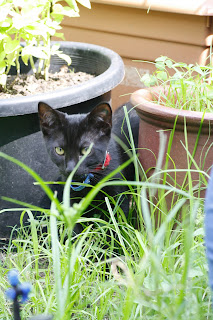Its fairly well established that you should lock your cats in at night. The theory says, cats are more likely to get in trouble overnight, it is their natural hunting time, they are more likely to have fights and they are more likely to get hit by a car. Additionally many local councils in Australia have a cat curfew, were you are required to keep your cats inside at night. So as responsible cat owners, we try to lock our cats in at night.
But there are some nights, they just don't come home, regardless of calling of them or attempting to entice them with tins of tasty cat food.
So the question becomes what does my cat do at night? A question I am sure all cat owners have asked themselves. Where is my cat? At an all night raves? Having wild kitty sex? Hunting the native wildlife? Is my black cat chasing cars in the black night? Given Magellan didn't come home the other night while wearing the GPS logger, we decided to find out.
Firstly, to go back to our previous post, where we talked about the search for accurate data. Nigel has finishing his coding, built his data base and has produced data sets with all the required attributes and we can now filter the cats movements using horizontal dilution of precision, these filters can then be used to show us the accuracy of the data.
The map below shows 13 days worth of data from Magellan. This data is filtered using horizontal dilution of precision and then presented using colour coding. By doing some clever maths you can assign dilution of precision values. I'm really bad at maths, if you like maths - read this link to explain how it all works
http://en.wikipedia.org/wiki/Dilution_of_precision_%28GPS%29
In the map below, the green dots represent data we consider to be good precision. Yellow is okay precision. Orange and red is most likely to be really bad and unreliable data.
So you can see if the non geek was was looking at the straight output from the GPS logger it would appear that Magellan is travelling up to 520m from our house in any direction. However, once you filter out the unreliable data, it appears he is much more of an home body and is only travelling around 120m in any direction from our house. Its also something of a relief to note that he is only regularly crossing one street and it is the quiet suburban street in front of our house.
Now we only have one nights worth of data for his night time adventures.. This data has been filtered to only show data between 7pm and 7am (which is pretty much between dawn and dusk at this time of year).
Interestingly it shows pretty much the same level of travel as his daytime roaming, in fact at night time he apears to be roaming even less, with the furthest distance from our house being 86m. So when you are calling them at night, its not that they can't hear you, it is that they are ignoring you. He appears to be going no further than 3 houses away. But then I guess when you are cat sized, the world is your jungle and you find your adventures where you can.
Now I realise that one nights worth of data is a statistically insignificant data set, but we are still trying to keep them in at night. So it is probably time to return to our original question of does Corsair have another home? Or does Jumble really sleep all day? Its time to take the logger off Magellan's collar and collect more data from the other cats that we can analyse using the new data collection protocols.




I am really enjoying your work! as does everyone I've shown it to. I am pleased as punch that you're able to do this with Open Source tools. Keep the posts coming!
ReplyDelete